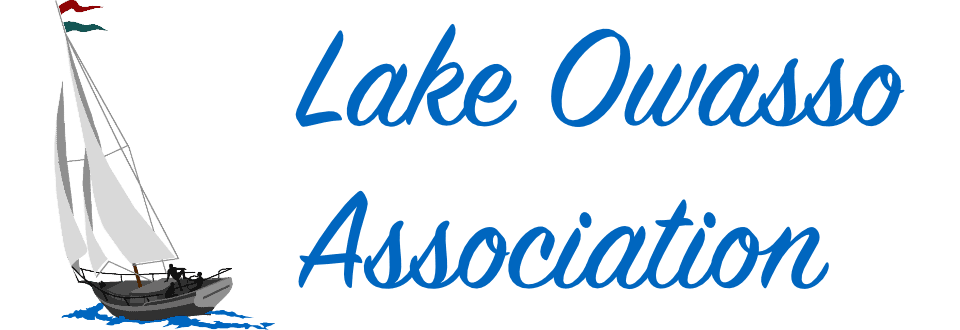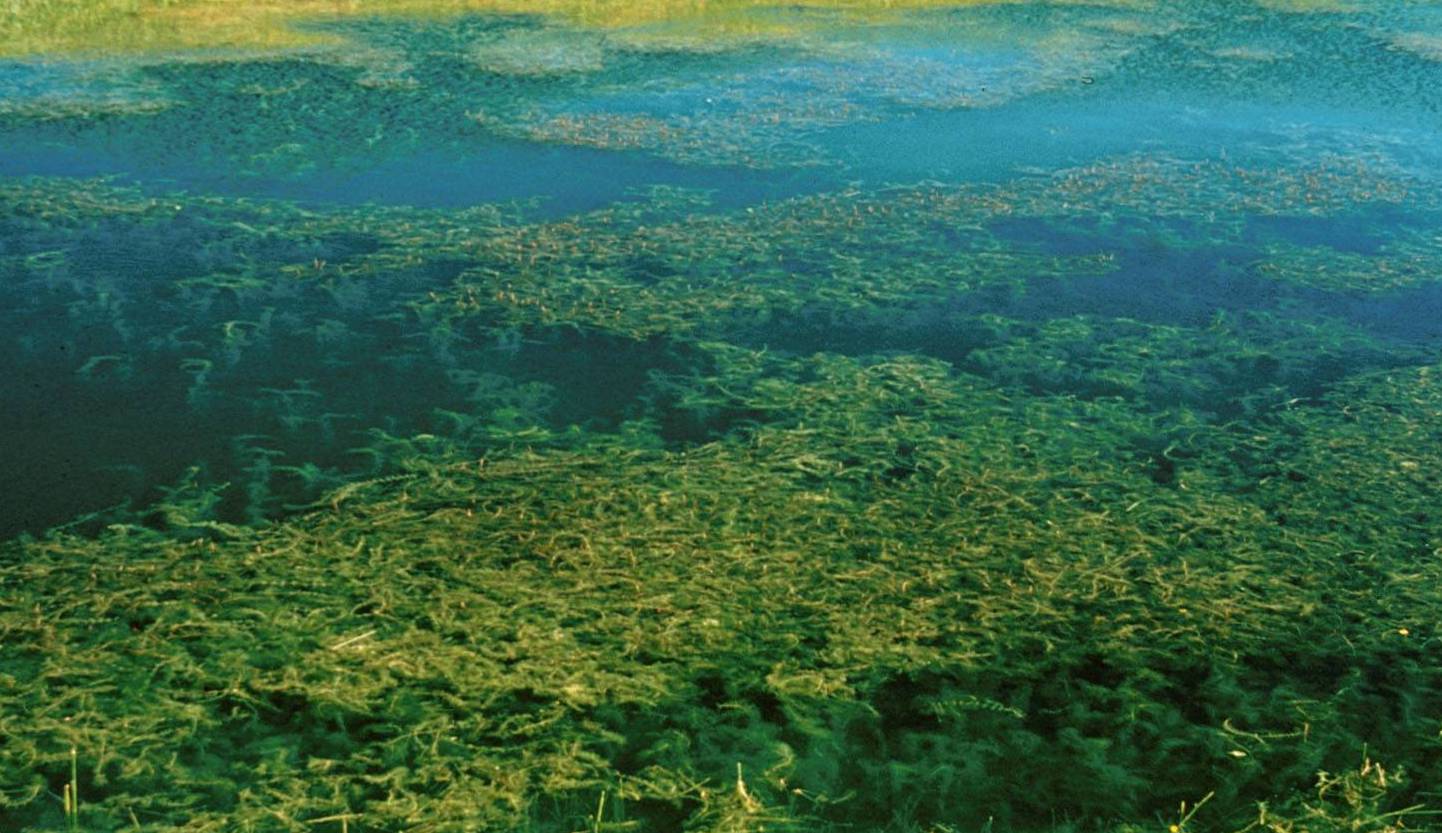An alternative treatment method for Eurasian Watermilfoil.
Q&A prepared by the LOA Board, April 2023.
Introduction
Visual observations throughout 2022 by several Lake Owasso Association (LOA) board members, other lake residents, and the treatment contractor (Lake Management, Inc.) have all reported ample increases in Eurasian Watermilfoil (EWM) throughout much of Lake Owasso. According to the treatment contractor, the increasing level of EWM on the lake is progressively difficult to effectively treat using the existing treatment method. The LOA board is investigating an alternative treatment (fluridone) that several metro area lakes have used to treat EWM. Fluridone is relatively expensive but also a very selective and effective treatment against EWM. Continued research is required before and if the board recommends the use of fluridone on Lake Owasso. However, because of the heightened cost and permitting requirements, research must occur early on, to enable fluridone treatment several years out. To help address questions that residents and other lake users may have related to fluridone, the LOA board has assembled the following Q&A.
What is fluridone and how does it work?
Fluridone is a systemic herbicide that stops a plant’s ability to make a pigment used to protect itself from the sun breaking down chlorophyll. (Systemic herbicide meaning fluridone is absorbed into the entire body of a plant tissue, vs a contact herbicide).
Who is the manufacturer of fluridone?
Fluridone is manufactured by SePro under the brand name Sonar. While Sonar is not extensively used yet in MN, (used a lot in FL) it has existed for decades. The origin of fluridone is Dow Agro Science headed by Bill Culpepper. SePro was formed 27 years ago from the research that came out of Dow Agro Sciences. The patent protection on fluridone is now expired. SePro is headquartered in Carmel, Indiana, with a research arm in North Carolina.
If the patent on fluridone has expired, why is fluridone still relatively expensive?
The size of the aquatic herbicide market (unlike terrestrial herbicides) is not large enough to attract the likes of Dow, BASF, Monsanto (Bayer). Terrestrial herbicides benefit from economies of scale unlike what exists in the aquatic herbicide market.
Is there a way to reduce the cost of a fluridone treatment?
Yes, with Sampling and Signage. The LOA board is sensitive to the cost increase associated with fluridone. While the board cannot control the actual treatment cost, there is opportunity via additional board volunteer work, to reduce associated costs to minimize financial impact on residents. A whole lake fluridone treatment requires as many as 24 subsequent water samples for testing at a certified lab. Collecting samples involves a labor cost. The LOA board is allowed and will volunteer (after training) to collect these samples, thereby reducing expense born by the treatment contractor and passed onto the LOA. For a whole lake fluridone treatment, the DNR allows for e-posting (email notification) as an alternative to the orange physical sign you are accustomed to seeing. Likewise, the LOA board will notify you via email just after the initial fluridone treatment and subsequent bump treatments to eliminate the cost associated with signage.
Where is fluridone commonly used?
Fluridone is used where EWM has gotten out of control, beyond the capability of traditional treatment methods.
If the LOA board recommends treatment with fluridone, when would such a treatment start?
Based on the cost factor and additional permit requirements, the earliest fluridone treatment could occur is in 2024. There is no chance that fluridone would be used in 2023, so we will instead use the existing treatment method.
Is fluridone applied each year as with the existing treatment method?
No. The expectation is that a fluridone treatment against EWM will last between 3 and 4 years. Fluridone (unlike shoreline treatment) has a full lake-wide dilution spread where most regulators aim to achieve a concentration of 4-5 ppb throughout an entire water body. As the ppb concentration gradually falls, “bump treatments” are used to keep the concentration at the 4-5 ppb designated target. This does not mean that there is no treatment the year following a fluridone treatment. For example, a modified shoreline treatment may occur the year following a whole lake fluridone treatment.
If there is a fluridone treatment on Lake Owasso, will I still get my shoreline treated? No, not in the year of a fluridone treatment. The nature of fluridone treatment is whole lake treatment through dispersion. The idea with whole lake treatment is that the dilution effect is more widespread than traditional treatment where the effect of the treatment applies to the entire lake. So even if your shoreline is not specifically treated, the effect on EWM will still be realized along shorelines. Also, for the year a fluridone treatment is applied, DNR regulations prohibit additional shoreline treatment that we normally experience.
Given the effectiveness of fluridone on EWM it sounds a bit like the “be all end all”. While fluridone has proven to be very selective and effective against EWM, other invasive (sometimes native) plants can fill in the void. Other lake associations have often treated other plants that have filled that void with traditional treatment methods in the subsequent year following a fluoridone treatment.
Is fluridone applied with a spray hose or wand as used with the existing treatment method?
No. Fluridone is applied via a subsurface injection at various points throughout a water body. Thermocline (the variation in water temperature in the water column) is a critical parameter that must be assessed before a fluridone application.
If fluridone treatment were applied on Lake Owasso vs the current method, would I still receive a sign posted on my lawn?
Yes. Since fluridone is a whole lake treatment approach, applicators are required by DNR rules to post a sign on every parcel.
What restrictions exist after a fluridone treatment?
The restrictions are less than the current treatment method.
I have always been told to be patient and expect about 10 days after treatment before I see an effect on my shoreline. Should I expect that same 10-day delay after a fluridone treatment before I see and effect?
A drawback of fluridone is that it takes longer (up to 60 days) before it influences EWM. As such and given our short summers, some applicators are treating with fluridone earlier in the spring or sometimes even in the fall (to incubate or jump start) reducing plant abundance during peak lake usage. However, the challenge is that certain thermocline parameters must also be met for
effectiveness. The LOA board is researching the implications of both early spring and fall applications. The idea behind an early spring or late fall treatment is to allow more time for treatment effect before peak lake use.
With exactness in the ppb range, how does the applicator or the DNR know they are achieving such precision?
A major part of a fluridone treatment is subsequent water sample collections, which are sent to a certified reporting lab to ensure the desired ppb level. Both in terms of treatment (sub-surface injection) and subsequent monitoring, fluridone is a very technical method of treatment.
Are there DNR or other grants available to help offset the cost of fluridone treatment?
The DNR’s annual budget for aquatic invasive treatment grants is limited. The LOA board monitors DNR grant announcements, in the event of a funding opportunity.
What metro area lakes have used fluridone as a treatment method?
Lake Josephine, Long Lake in New Brighton, Clear Lake in Forest Lake, and Lake Demontreville in Lake Elmo, are four lakes we are aware of. LOA Board members have initiated dialogue with lake association officials from three of these lakes with a yet-to-be-scheduled meeting with a fourth lake. The more that can be learned about other fluridone treatments, the better informed the LOA will be toward any future recommendations. If anyone has knowledge of fluridone treatment from other lakes, please share it with the LOA board (info@lakeowassor.org).

Tri-fold brochure for print:

